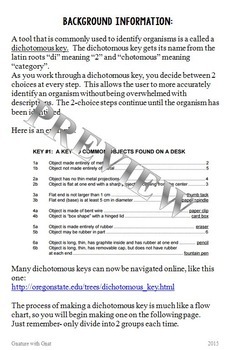Dichotomous Key Activity
※ Download: Dichotomous key activity
As students progress through the unit the answers should become more accurate. A Key to New Pamishan 1. How accurate and user-friendly was their key for users? Have them make an answer key on another paper and paste it to the back of their key.

You simply compare the characteristics of an unknown organism against an appropriate dichotomous key. Through NSTA, you'll find leading resources for excellence in teaching and learning and experience growth through robust professional development. Once you find your worksheet, click on pop-out icon or print icon to worksheet to print or download. Have students write notes during the video and then discuss them afterwards.

Dichotomous Key - Through NSTA, you'll find leading resources for excellence in teaching and learning and experience growth through robust professional development. Students will apply taxonomy by continuing to solve dichotomous keys, but this time on living things.

Classification is very important to the field of biology. As we continue to discover new species, learn better techniques for analyzing relationships between species i. DNA analysis and share information internationally it is important to have systems in place to identify and classify organisms. A dichotomous key is a tool that helps to identify an unknown organism. A dichotomous key is a series statements consisting of 2 choices that describe characteristics of the unidentified organism. The user has to make a choice of which of the two statements best describes the unknown organism, then based on that choice moves to the next set of statements, ultimately ending in the identity of the unknown. Dichotomous keys are often used in field guides to help users accurately identify a plant or animal, but can be developed for virtually any object. They are particularly helpful when two species are very similar to one another. This project is about learning how to use a dichotomous key to identify plants or animals. Through the process of creating their own dichotomous key and field guide the student will sharpen their observation and classification skills, both of which are necessary for success in upper level science courses. The student also builds an appreciation for nature through extended periods of observation. Problem: Learn how to make a dichotomous key. How can we use a dichotomous key to identify plants or animals? There are a variety of ways you can design a dichotomous key, and they can be used to identify pretty much anything. Figure 1 below is a dichotomous key for types of potato chips, and Figure 2 is one for identifying organisms. Start with the most obvious features of the item and move to more specific statements. Remember, each statement must have 2 choices. For example you might start by creating a dichotomous key to identify students in your class. Begin with very general statements: Is the student male or female? Does the student have blue eyes or brown eyes? Does the student wear glasses? You can set up your key as a flow chart, or as a grid. Use the dichotomous key in the tree identification guide you have to identify it. For example: if you choose 5 types of tree what are some of the shapes of the leaves? What color is the bark? Use pictures and text just like one of your field guides. Disclaimer and Safety Precautions Education. By accessing the Science Fair Project Ideas, you waive and renounce any claims against Education. In addition, your access to Education. Warning is hereby given that not all Project Ideas are appropriate for all individuals or in all circumstances. Implementation of any Science Project Idea should be undertaken only in appropriate settings and with appropriate parental or other supervision. Reading and following the safety precautions of all materials used in a project is the sole responsibility of each individual. For further information, consult your state's handbook of Science Safety.
After working through a couple of more couplets, it may become apparent that one fork does not fit your sample at all. Question 1: Is the person male or female. The creature has hair spikes. Follow to the next step indicated and read that set of statements. Students will be given a quiz. It includes Dichotomous key activity and PDF handouts for students. Observe their progress to verify understanding. A dichotomous key provides users with a series of statements with two choices that will eventually lead to the correct identification of the organism.



